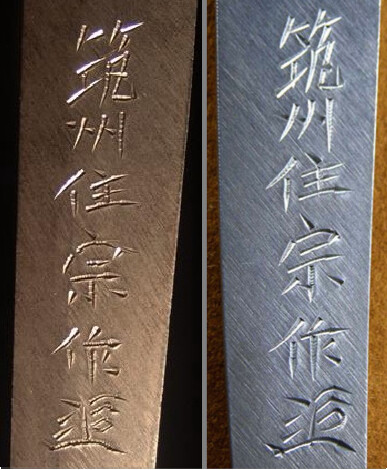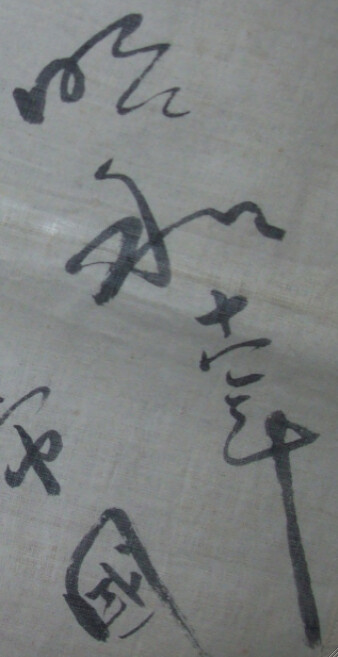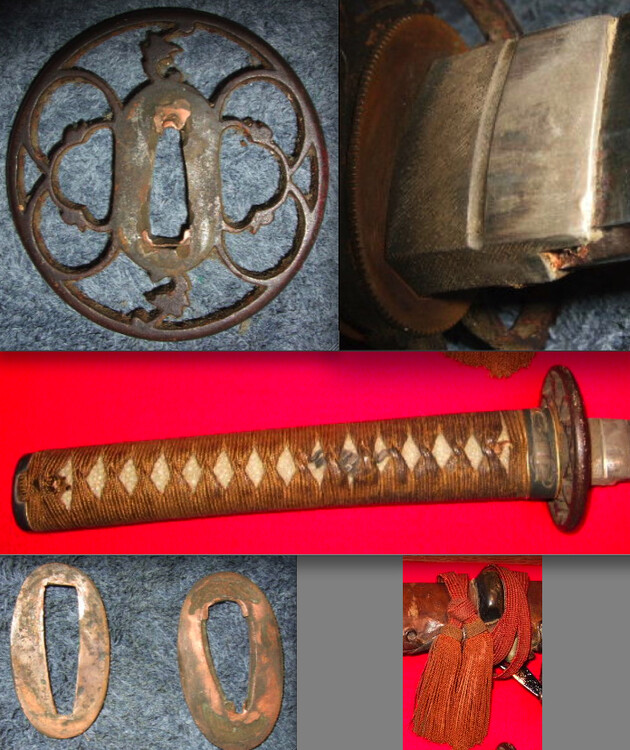-
Posts
778 -
Joined
-
Days Won
1
Content Type
Profiles
Forums
Events
Store
Downloads
Gallery
Everything posted by reinhard
-
Finally we get a picture of Guido's evil twin. reinhard
-

Translation assistance on Chinese Auction (?)
reinhard replied to SwordGuyJoe's topic in Translation Assistance
-

Are Gimei blades worth collecting?
reinhard replied to Gabriel L's topic in General Nihonto Related Discussion
You may speak on behalf of yourself, but believe it or not: There are many "discriminating gaijin" in the west trying to make a difference, i.e. trying to learn about quality levels and not just accepting any Japanese blade as some kind of miracle. Statements like yours (and Gabriel's) are setting the learning process on this board back to field 1. Gimei were put there for a reason and these blades never live up to the expectations their false mei rise. Serious Japanese judges have good reasons to ignore gimei swords and these are the reasons why these blades should be avoided by collectors. All gimei blades I've come across during the last 20 years or so were not worth any further investigation. - I know, some of you get excited about any ugly cluster of mura-nie somewhere on a blade, hollering "nice hataraki!" and so on, but this is actually far from serious appreciation of NihonTo. As long as you let the gimei stay and will not put it to Shinsa, it's just a blade, neither Kamakura nor anything else, for your judgement just doesn't matter. reinhard -
-
The mei eventually reads: Minamoto (no) SHIGETORA A ToKo by this name worked in Osaka during late 17th century. I couldn't find any reference material though. reinhard
-
Hi Mariusz, Thank you for sharing your collection. It seems I've got the twin brother of your Owari tsuba. Did you get any expertise for yours? Mine was never put to Shinsa and I neglected it for some time. Your post made me pick it up once more. reinhard
-
Soshin, Design, craftsmanship, surface and color of steel, shape of seppa-dai and so on are pointing towards a later date of manufacture: Very late Edo period or later. reinhard
-
It is not (at all) Every sharpened screwdriver does as well. reinhard
-
Signed on the sashi-omote, so you better not get too excited. reinhard
-

Munetsugu Gimei(I think) Could use some help!
reinhard replied to Kazuto49's topic in Translation Assistance
Matt, 12th year of Tenpo era is 1841. First year of Tenpo is the equivalent of 1830 and must be counted as 1 not zero. I'm mentionning this, because it is a common mistake. Apart from that you are right. Koyama MUNETSUGU was awarded with the "Bizen-no-Suke" title in 1845. A genuine mei including this title dating from 1841 cannot exist. reinhard -
Hi Charlie, For someone with a general interest in Japanese swords at the very beginning of his search I recommend : - "The connaisseur's book of Japanese swords" by Nagayama Kokan - "The Japanese sword" by Sato Kanzan - "The craft of the Japanese sword" by Yoshihara Yoshindo, Leon and Hiroko Kapp Having read those I'd suggest: - "Nihon-To art swords of Japan" by W.A.Compton, Homma Junji, Sato Kanichi and Ogawa Morihiro - "Japanese swords and sword furniture in the museum of fine arts Boston" by Ogawa Morihiro - "Selected fine Japanese swords" published by NBTHK's European branch, Solingen, 2002 - "The influence of MASAMUNE" by NBTHK's American branch in 2003 - "Meito and Yagyu tsuba" by NBTHK's American branch in 2005 If you have a particular interest in army swords (GunTo): - "Military swords of Japan" by Richard Fuller and Ron Gregory If you have a particular interest in polearms: - "Japanese polearms" by Roald M. Knudsen Last but not least there are some books I advice NOT to buy/read, for they are completely outdated and/or contain many mistakes: - "The Samurai sword" by John Yumoto - "The arts of the Japanese sword" by B.W.Robinson - "The Japanese sword" by Inami Hakusui A word about Hawley's compilations: Willis M. Hawley collected an enormous amount of information during his lifetime and we owe him gratitude for this achievement alone, but his ratings are still quoted nowadays by many sword dealers and collectors even on this board and this is nonsense, of course. He never really managed to organize the wealth of information he collected in a reasonable way. His books are good points to start a search from. Infos about some long forgotten smiths can be found, but they represent the beginning of a search, never its end. From there on only Japanese literature will help you any further reinhard
-
I agree with Ludolf’s guess. Probably the other way round. TOSHIHIDE made the blade and YOSHINAO carved the horimono. At least that's what the saya-gaki says. BTW, it dates from Showa Kinoto-I (10th year, which is the equivalent of 1935 AD). Obviously it belongs to this blade. Nagasa of this wakizashi should be: 1 shaku 4 sun 7 bu. reinhard
-
The addition of tsuchinoe-uma makes it Kansei 10th year for sure. reinhard
-

Yasuyoshi Kinmei, who is the attribution by?
reinhard replied to Adrian S's topic in Translation Assistance
Interesting enough, the two katana blades on the sites provided by Moriyama-san (Aoi and "auction.women.excite") are the same sword. Same measurements and many other details are proving it. The kinpun-mei look slightly different though. On Aoi's site the kanji for "TSUNA" is partially erased and looks more real, whereas on the "auction.women.excite" page, it looks perfectly intact at first sight, but not quite as reliable considering the picture's quality. - It doesn't really matter in this particular case, for kinpun-mei from Meiji times are not of real importance, but this is a good example for showing the importance of staying cautious when buying online. Many times you don't get what you see when buying on the basis of pics and descriptions. Nihon-To is about most subtle details and nowadays most people are just not used to this kind of perception anymore. My advice would be: Check as carefully as you can, then check again and after a while: check again. Collecting NihonTo is not about being quick. It is about looking carefully at the real thing. Dealers may have other priorities though. reinhard -

can i get a reading on this paper please.
reinhard replied to micko's topic in Translation Assistance
Hamon is said to be "gunome midare ha". The name of the expert is Mr. Kobayashi Yukinobu. reinhard -

Question: Regarding Tanto Mei. Were dates used without mei?
reinhard replied to nihonto1001's topic in Nihonto
No, they didn't. But it was said before that some mei were deliberately removed (mostly for commercial reasons). - There is a magnificent naginata (juyo token) in Europe, obviously made by Bizen MOTOSHIGE and with full-length nakago, but the mei (including the maker's name) was removed a long time ago. The traces of the removal can still be seen. All that's left is a nengo dating from 1343. Unfortunately this practice started a long time ago and some very precious informations are lost forever by now. reinhard -
Some collectors are still fascinated by the myth of "the" MURAMASA, although there were at least two generations by this name in Ise province, maybe three. It is true that many of their mei were changed or even erased during Edo times, but this particular one was not obliterated enough. The top two kanji on the sashi-omote can still be read as: "Bishu" meaning Owari (province). Unfortunately no MURAMASA ever worked in this province as far as I know. It must have been the mounting then, or somebody will be really disappointed soon. reinhard
-

Question: Regarding Tanto Mei. Were dates used without mei?
reinhard replied to nihonto1001's topic in Nihonto
Provide us with an example, please. It will help us to understand what you are talking about. reinhard -
Felipe, Etchu NORISHIGE is one of the greatest names in the history of Japanese swordmaking. His blades don't pop up just like that once in a while. If one of his blades with full naga-mei existed, it would have been a treasure four hundred years ago, well documented and stored in fittings appropriate to its value. - Your sword is a rather naive and therefore old forgery. You better focus on the blade itself and forget about the mei. - BTW the one pic of mei including name and province is a composition of different fragments. When checking mei, it is desirable to get pics of nakago taken as one shot and depicting the entire nakago. Thanks. reinhard
-
The habaki says it all. reinhard
-
Mark, There is no standard procedure of how to verify/falsify a signature. What goes for KOTETSU and Kajibei cannot be applied to nidai TADAHIRO's mei and some minor changes occuring during his long span of working. Both mei look quite allright to me and what's more important: They are placed where they should be. reinhard
-
Compare this kanji "Shin" with any true and verified version of SHINKAI's mei. Jacques showed you the way. reinhard
-
Don't give in too quickly, Sean. Problem is: State of preservation allows hardly any conclusions about quality or characteristics of this blade. On the other hand, nothing seems to be obviously wrong with it so far. - I wished the area underneath the habaki revealed some news, for it is usually the best protected area on deteriorated blades, but for some reason, it looks even worse. (This is supporting the "mismatching koshirae"-theory, BTW.) Advice (or even expertise) on the basis of pictures is very difficult in a case like this. You better show this blade to an experienced collector whom you can trust. We could go on speculating wildly for some time, but this is probably not what you are looking for. reinhard
-
This mei reads : Inoue SHIN(KAI), but it doesn't really matter, for it is subsonic (gimei). BTW a real name besides your avatar would be nice/is expected. reinhard
-
Hi Sean, When trying to understand this sword you better separate the blade from its koshirae. This particular koshirae is an occasional assembly of mismatching parts. There are a leather frog and a tassel pointing towards WWII, but the tassel is not where it is supposed to be. Tsuka and tsuba seem to be of earlier date, but at a closer look they are not. The crossings of tsuka-ito are all made in the same direction and the diamond shapes in between look poor. This is pointing towards a later date of manufacture. The habaki is not fitting the blade properly. Seppa are asymmetrical and of poor quality. - All in all you better focus on the blade. The koshirae can be neglected. reinhard













